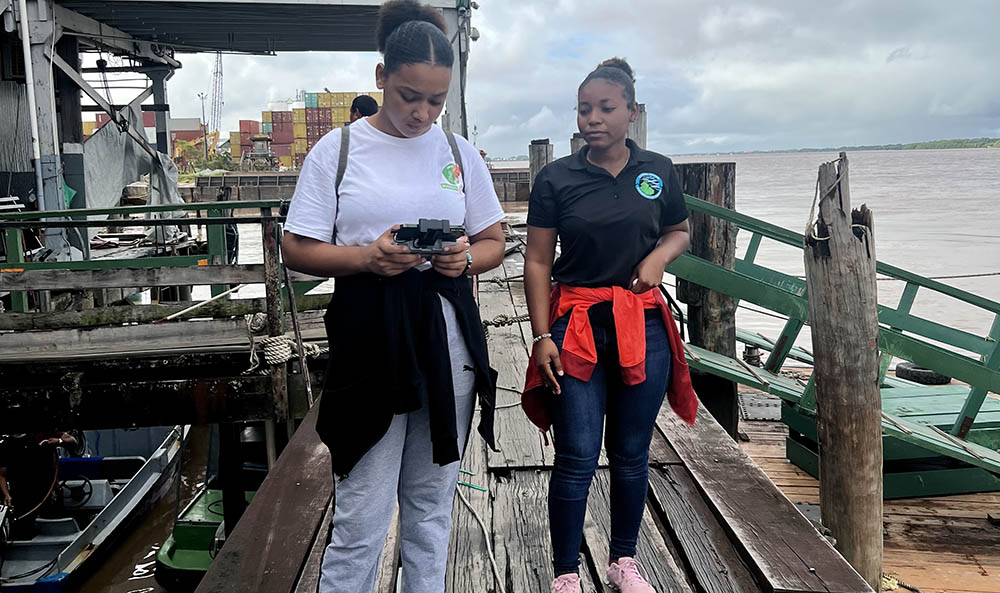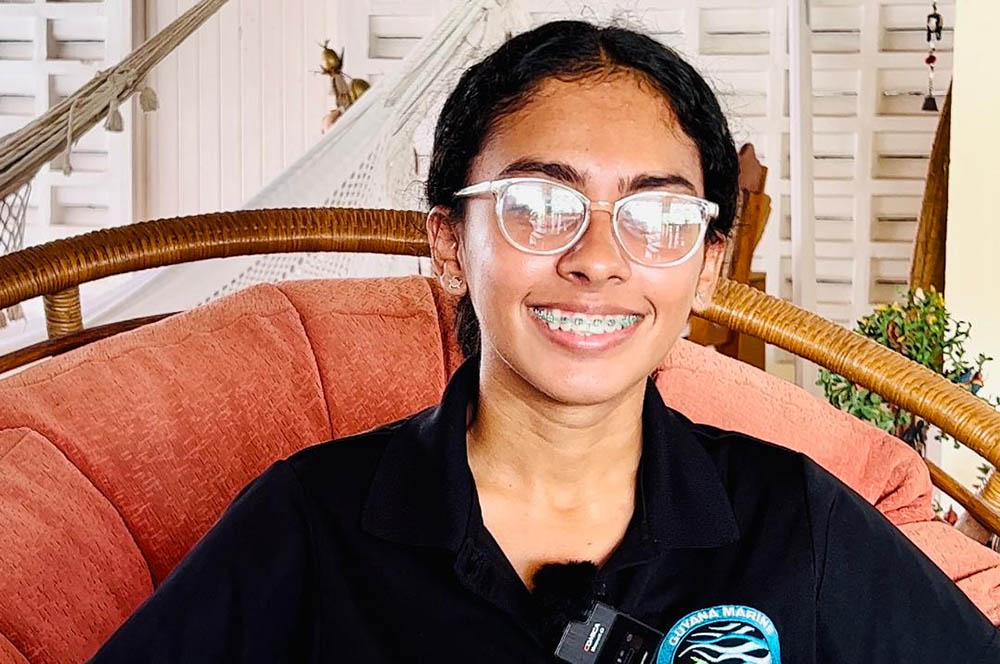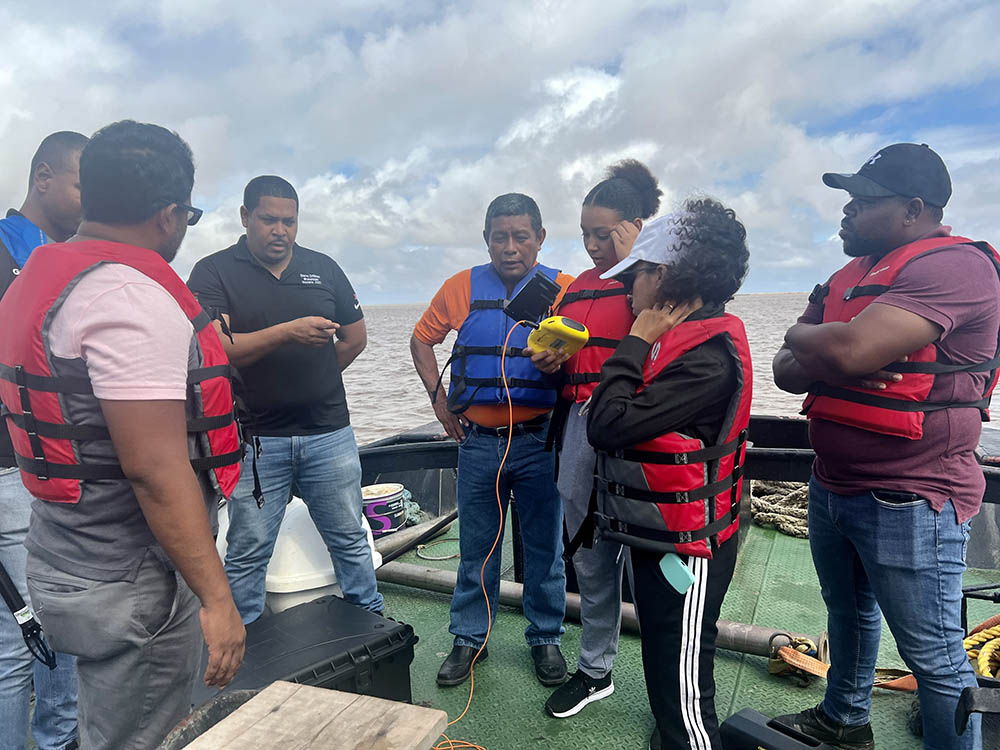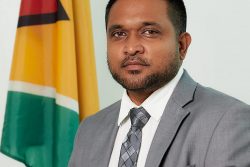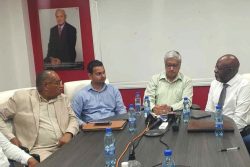By Shabna Rahman
Four indigenous girls from the Barima-Mora Passage Area (BMPA) have been trained to operate aerial drones to ensure that mangrove ecosystem and wildlife biodiversity throughout Region One is monitored and protected, as part of an ongoing project.
The Barima-Mora Drone Unit is part of a four-year project, titled: ‘Securing the Future of the The Barima-Mora Passage Mangrove Ecosystem and its People’ and is managed by the Guyana Marine Conservation Society (GMCS).
During an interview, Sarah Singh, a technical officer with the GMCS, told the Sunday Stabroek that during some droning exercises, they have noticed illegal cutting down of mangroves, as well as fuel pollution. She said the illegal activities have been reported to the “relevant agencies so that they can take corrective actions.”
The project for the BMPA, which has the largest intact mangrove ecosystem, funded by the IDB lab – an innovation laboratory of the Inter-American Develop-ment Bank Group – was started in September 2022 and will end in September 2026.
Head of the GMCS Annette Arjoon told this newspaper that the project consists of three components: Massive Indigenous Communities Stakeholders Consultation, establishing Green Businesses to reduce the pressure on the mangroves as well as Guyana’s first Blue Carbon Baseline and piloting a Community, Monitoring and Reporting and Verification system.
She said the GMCS is “using the girls in the community, by building out their skills. The intention is to have 12 young indigenous girls in the Barima-Mora passage communities, who are armed with technologies and the skills to enable their robust monitoring of these precious areas, not only the mangrove ecosystem, but also to do some marine research near shore.”
The drone training is conducted by GuyDrones and the young women who are currently in Georgetown, are also acquiring skills in using the Remotely Operated Vehicle (ROV) or underwater drones.
Upon completion, they will return to their villages and conduct practical exercises to actually monitor areas like the Barima River and the lower Kaituma River.
“We are excited about the underwater drones because we are now at a place where we will be able to discover things and share our knowledge and educate the public. A lot of people don’t know what we have underwater…,” Singh, a marine biologist, said.
The team is thrilled to have opportunities to operate the ROV outside their communities. For instance, they will be exploring a freshwater coral reef in the Berbice area as well as shell mounds of the Pomeroon River.
In fact, the Maritime Administration (MARAD) has already used their services to conduct an offshore demonstration to its team in the Demerara River.
MARAD will also take advantage of their skills in finding a shipwreck located 17 kilometres off Mahaica River and the team is beyond grateful for the collaborations, as it would definitely help to build their experience and capacity.
Shakira Yipsam of Aruka Mouth, who serves as the field officer and team leader, said it has been great working for the GMCS. She found the drone training, which included several practical sessions in pools, very rewarding, as she is now armed with the skills of operating and controlling the drones.
Arjoon thanked the Coastguard and MARAD “immensely for their support in building the capacity of the indigenous girls, by giving them that real offshore experience, because they could not have afforded it on their own.”
Yipsam said her “experience has been great because I started off working as a CSO [Community Service Officer] and to know that I got the opportunity to grow so much …and learn so much more, it feels great.”
Vianne Frens, a local content officer, who hails from a small community called Morawana, is also grateful for the vast knowledge she has gained, especially about the environment and ways to protect it. She plans to use the information in a sustainable manner.
They are also undergoing local content training, which entails them posting videos and telling their own stories about their communities. They have recently created the Barima-Mora Passage FaceBook and Instagram pages and encourages everyone to follow them to learn more about their amazing communities.
Good access to Shell Beach
The BMPA, which spans about 50,000 hectares, with 14,000 being covered in black, red and white mangroves, has good access to the Shell Beach Protected Area.
Shell Beach was established about 25 years ago and is one of the world’s premier nesting places for several species of sea turtles. It was created as Guyana’s First Coastal Protected area for sea turtle conservation.
According to Arjoon, “From 2000 to 2015, it was all about sea turtle conservation and ecosystem protection and once the Protected Areas Commission was formed, we started to work outside of the protected area.”
The focus was then turned to the BMPA because it is the “largest mangrove forest [in Guyana] at the time of global warming and climate change, and especially because mangrove sequester five times more carbon than any other forest, it is very important that they protect the area,” Arjoon pointed out.
She said it should not only be protected because of the “carbon sequestration and value, but also the fact, that without the mangroves, the Warrau community from Imbetaro, Smith’s Creek, Morowana and Aruka, would have no crabs or fish, which are their main sources of protein.”
Sequestration is when the mud and silt are trapped in the root systems to foster chemical balance of the freshwater swamps and wetlands. As such, the mangroves create and preserve soil systems with low oxygen levels.
The soil and water systems in turn, prevent the decomposition of organic matter, such as the fallen leaves and branches. This helps the carbon contained in the organic matter to be stored in the ground and not released in the atmosphere, making the BMPA one of the world’s most valuable carbon syncs.
It was noted that if the area were not protected, the Warraus would not have the mangroves to assist them with flood protection, their farms would flood easier and there would be massive damage to the wildlife in the mangrove forest, which is the most invaluable part of bio-tourism.
A camera-trapping project done in the area, Arjoon said, had shown that “out of the mammals that are found there, seven species are on the IUCN International Union for Conservation of Nature list]. And that is a big deal… it means that the species that remain are very valuable and they need to be protected and conserved.”
On the other hand, she said, a fisheries study showed that “the size of the fishes in the area are seven times larger than those found in regions two, three, four, five or six.”
Another plus for the Warrau communities, is that through a birding study, she said, it was discovered that “there are two species of birds that can only be found in this area and no other part of Guyana. They are the black chested tyrant and the belted kingfisher.”
Imbotero Research Centre
Arjoon sees the establishment of the fully solar-powered Imbotero Research Centre as one of the “proudest accomplishments” of the GMCS. It is the first marine coastal-focused ecosystem research centre in the region and is one component of the IDB lab project.
Since its establishment in 2020 under the Global Environment Facility Small Grant Programme, the GMCS has “hosted several local and international researchers who have done phenomenal jobs… More researches would be conducted this summer, on the primates in the area as well as on the watersheds and the importance of its management. So it is a really wonderful time to be working on this project ,” Arjoon said.
Singh described the BMPA as “one of the most peaceful and open areas. It is like you are in a different setting, especially for people going there from Georgetown, and as in my case… It blew my mind!”
The BMPA has “millions of topics to be researched”, Singh said and she felt fortunate that she was able to “conduct a research on crabs and heavy metals in crabs. I met people who were very open and friendly and who supported my research. I was proud and happy to go back with my results and share it with the people…”
The research centre has provided job opportunities for the people in the village, such as the manager, the tour guide and a cook.
The Barima-Mora Passage, Arjoon said, has a lot of “potential for tourism and one of the plans is to have self-contained birding cabins so that the researchers can come” and be accommodated comfortably. “In this area there are so many bird species, like the two previously unrecorded bird species.
“There is a huge potential for birding in the area, especially the income it can bring in for the villagers who are providing tour guiding services to the visitors.
“The area has a vast amount of mangroves which is a perfect habitat for the bird species, especially the scarlet ibis, the crimson-hooded manakin and the parrots and macaws.”
Another component in the green enterprise is the wiri-wiri pepper project that was set up in a village called Smiths Creek, through the Canada Fund for Local Initiative.
According to Singh, “The pepper species is different from the regular ones; it is very tiny but flavourful and is grown only in that region. There are two groups of women that are planting the peppers. They would harvest them and process them into pepper flakes and pepper jelly to be sold in the local and international markets.”
Beekeeping is another component in the green enterprise and interested beekeepers in the villages of Aruka, as well as Morawana and Imbetero, received training and support.
The last component expected to start soon, is a blue carbon baseline, which involves measuring the amount of carbon in the mangrove forest and in the wetlands and adding a value to that, as well as developing a Community Monitoring Reporting and Verification System.
“This will allow the villagers to independently monitor and report the activities in their communities and they will be able to manage it better, like the natural resources and use it in a more sustainable manner,” Singh said
Meanwhile, Arjoon said the GMCS is “growing out towards building the capacity, where we can go out there and collect all of the data” for agencies such as the Environmental Protection Agency, National Agricultural Research Institute and Guyana Forestry Commission, the Ministry of Natural Resources.
She expressed thanks to IDB lab, the governmental partners, the Regional Administration of Region One and the chairman Brentnol Ashley, and Regional Executive Officer Teka Bissessar for their invaluable support.
She mentioned too that the GMCS is hosting a two-day empowerment workshop for 55 women from 55 communities in Region One and that the region has allowed them to use its boardroom.


